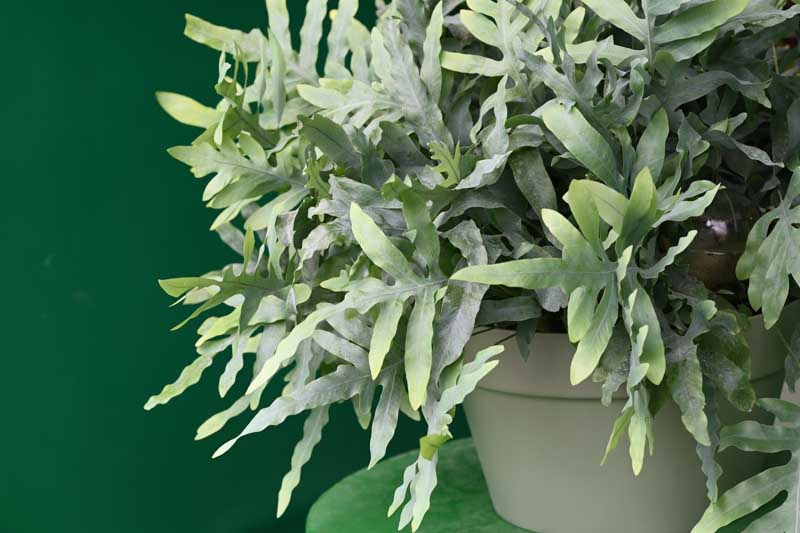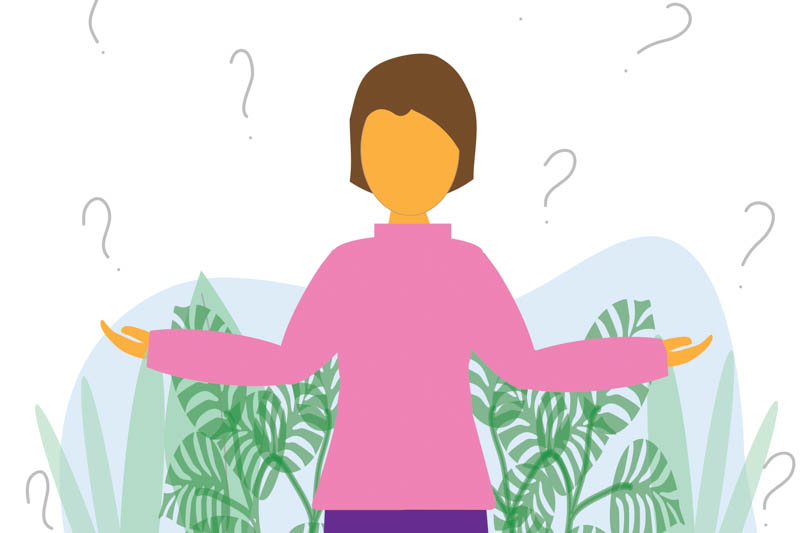Cabbage Palm Fern, Golden Polypody, Gold Foot Fern, Hare Foot Fern, Rabbits Foot Fern, Blue Star Fern, Polypodium aureum, Chrysopteris aureum
Phlebodium aureum, commonly known as the Blue Star Fern, is a distinctive fern variety celebrated for its unique aesthetic appeal and relative ease of care, making it a favorite among houseplant enthusiasts.
Phlebodium aureum boasts an attractive, blue-green foliage with a soft, almost velvety texture. The fronds are irregularly divided, giving the plant a somewhat wild and organic appearance. Its blue-tinted leaves set it apart from other ferns, adding a cool tone to plant collections.
Native: This fern is native to the tropical and subtropical regions of the Americas, including Florida, South America, and the Caribbean. It typically grows in the crooks of tree branches, absorbing moisture and nutrients from the air and decomposing organic material. It belongs to the Polypodiaceae family.
Plant Type and Habit: Phlebodium aureum is an epiphytic fern, meaning it grows on other plants or objects for support while not being parasitic. This rhizomatous fern has a sprawling habit with fronds that can arch elegantly, making it ideal for hanging baskets or elevated displays.
Size: The Blue Star Fern can reach up to 2-4 feet in height (60-120 cm) and 3-6 feet in spread (90-180 cm) when grown outdoors, with its fronds extending outward and creating a lush, full appearance. It grows much smaller indoors, about 2-3 feet tall and wide (60-90 cm).
Foliage: The foliage is the main attraction, with each frond displaying a unique blue-green hue and a wavy, lobed structure that can add texture and color contrast to plant collections. The fronds can reach 16 inches in length (40 cm).
Hardiness: It is hardy in USDA zones 8-13 when grown outdoors. Indoors, it can thrive in a range of environments, provided it is protected from cold drafts.
Award: Recipient of the prestigious Award of Garden Merit of the Royal Horticultural Society.
Uses: The Blue Star Fern is primarily used as a decorative indoor plant. Its tolerance for lower light conditions and unique appearance make it a popular choice for adding greenery to homes and offices. It’s also used as a companion plant in mixed containers.
Toxicity: Phlebodium aureum is non-toxic to pets and humans, making it a safe addition to households with animals and children.
Deer: The Blue Star Fern (Phlebodium aureum) is generally resistant to deer.
Benefits: In addition to its aesthetic appeal, the Blue Star Fern can help improve indoor air quality. Its large fronds are effective at absorbing common household toxins, contributing to a healthier living environment.
Growing and caring for the Blue Star Fern can add a unique and lush element to your indoor plant collection.
Light: Prefers bright, indirect light but is quite adaptable and can tolerate medium and low light conditions as well. In less ideal light settings, it will have a slower growth and less vibrant foliage. Avoid direct sunlight, which can scorch its leaves.
Soil: Requires well-draining soil. A mix designed for epiphytes or orchids can be a good choice, or a regular potting mix with added perlite for improved drainage.
Water: Keep the soil consistently moist but not waterlogged. Water when the top inch of soil feels dry to the touch. Reduce watering frequency during the winter months.
Temperature and Humidity: Prefers warm conditions with temperatures between 65°F to 75°F (18°C to 24°C). Protect it from cold drafts and temperatures below 50°F (10°C). Thrives in high humidity environments. Regular misting, a pebble tray, or placing it in a naturally humid room like a bathroom can help meet its humidity needs.
Fertilization: Fertilize lightly during the growing season (spring and summer) with a balanced, diluted liquid fertilizer every 4-6 weeks. Do not overfertilize.
Pruning: Pruning is rarely necessary. Remove any dead or damaged fronds to keep the plant looking tidy and to encourage healthy growth.
Repotting: Repot every 2-3 years or when it becomes root-bound. Choose a pot only slightly larger than the current one to avoid excess soil moisture.

Propagating the Blue Star Fern is a rewarding way to expand your collection or share this unique plant with friends and family.
The best time to propagate Blue Star Ferns is during the spring or early summer, which aligns with their natural growth period.
Prepare: Begin by gently removing the fern from its current pot, being careful to minimize root disturbance.
Inspect and Divide: Look for natural separations in the root ball, where the plant has formed distinct clumps. Using your hands or a clean, sharp knife, carefully divide the root ball into smaller sections. Each division should have a good portion of roots and at least a few fronds.
Potting Up: Fill your new pots with the prepared potting mix and plant each division at the same depth it was growing before. Gently firm the soil around the roots to eliminate air pockets.
Water and Humidity: Water the newly potted divisions thoroughly, allowing excess water to drain away. To help maintain high humidity around the new plants, which is crucial for their recovery and growth, you can cover them with a plastic bag or place them in a more humid environment for the first few weeks.
Aftercare: Place the pots in bright, indirect light and maintain consistent moisture in the soil. Avoid direct sunlight, which can scorch the tender new growth. Remove any coverings once you see new growth, indicating that the plant has begun to establish itself.
While generally easy to care for, the Blue Star Fern can encounter pests, diseases, and common problems.
Spider mites: These tiny pests can cause yellowing and drop of leaves by sucking on the undersides. Increase humidity and use insecticidal soap to combat them.
Mealybugs: Recognizable by their cotton-like white masses, they suck plant sap, weakening it. Remove them manually using a cotton swab dipped in rubbing alcohol or apply insecticidal soap.
Scale insects: These can appear as small brown bumps on the stems and leaves, sucking the sap and reducing plant vigor. Scrape them off or treat them with neem oil.
Root rot: Overwatering is a common cause of root rot in Blue Star Ferns. Ensure the plant is in well-draining soil and in a pot with drainage holes. Water only when the top inch of soil feels dry to the touch.
Leaf spot diseases: These are less common but can occur in overly damp or poor air circulation conditions. Avoid wetting the foliage directly when watering and ensure good airflow around the plant.
Brown Tips on Fronds: This can be caused by low humidity, over-fertilization, or tap water with high levels of fluoride or chlorine. Use filtered or distilled water if possible, and maintain high humidity.
Leggy Growth or Pale Fronds: Insufficient light can lead to leggy growth or paler fronds. While the Blue Star Fern tolerates low light, it prefers bright, indirect light. Relocating the plant to a brighter spot can help restore its vibrant color and compact growth.
Dropping Fronds: This may occur due to a sudden change in environment, such as moving the plant to a drastically different lighting or temperature condition. Acclimate the plant gradually to new environments to minimize stress.

Blue Star Ferns (Phlebodium aureum) are considered to be relatively easy to care for, especially when compared to other fern species. They are adaptable and can tolerate a range of indoor environments, making them suitable for beginners. Key to their care is understanding their basic needs: they prefer bright, indirect light, high humidity, and consistently moist soil. Avoiding overwatering and providing the right environmental conditions can keep them thriving without too much fuss.
The most common problems encountered with Phlebodium Blue Star involve improper watering, insufficient humidity, and incorrect light conditions. Overwatering can lead to root rot, a common issue with many indoor plants. On the other hand, too low humidity can cause the tips of its fronds to brown. While it’s tolerant of lower light levels, insufficient light may lead to less vigorous growth and a leggy appearance. Addressing these care aspects can prevent most problems.
Phlebodium aureum can be grown both as an indoor and outdoor plant, depending on the climate. In regions with warm, humid conditions similar to its native environment (USDA zones 9-11), it can thrive outdoors in shaded areas that mimic the dappled sunlight of its natural rainforest floor habitat. In cooler climates, it’s typically grown as an indoor plant where it can be protected from cold temperatures and provided with a stable environment. Indoors, it’s prized for its air-purifying qualities and unique aesthetic appeal, making it a popular choice for enhancing living spaces.
| Hardiness |
8 - 13 |
|---|---|
| Plant Type | Houseplants, Ferns |
| Plant Family | Polypodiaceae |
| Genus | Polypodium |
| Exposure | Partial Sun, Shade |
| Season of Interest |
Spring (Early, Mid, Late) Summer (Early, Mid, Late) Fall Winter |
| Height |
2' - 4' (60cm - 120cm) |
| Spread |
3' - 6' (90cm - 180cm) |
| Spacing |
36" - 72" (90cm - 180cm) |
| Maintenance | Low |
| Water Needs | Average |
| Soil Type | Loam |
| Soil pH | Neutral |
| Soil Drainage | Moist but Well-Drained |
| Characteristics | Showy, Evergreen, Plant of Merit |
| Native Plants | United States, Southeast, Alabama, Florida, Georgia |
| Tolerance | Deer, Full Shade |
| Garden Uses | Patio And Containers |
| Hardiness |
8 - 13 |
|---|---|
| Plant Type | Houseplants, Ferns |
| Plant Family | Polypodiaceae |
| Genus | Polypodium |
| Exposure | Partial Sun, Shade |
| Season of Interest |
Spring (Early, Mid, Late) Summer (Early, Mid, Late) Fall Winter |
| Height |
2' - 4' (60cm - 120cm) |
| Spread |
3' - 6' (90cm - 180cm) |
| Spacing |
36" - 72" (90cm - 180cm) |
| Maintenance | Low |
| Water Needs | Average |
| Soil Type | Loam |
| Soil pH | Neutral |
| Soil Drainage | Moist but Well-Drained |
| Characteristics | Showy, Evergreen, Plant of Merit |
| Native Plants | United States, Southeast, Alabama, Florida, Georgia |
| Tolerance | Deer, Full Shade |
| Garden Uses | Patio And Containers |
How many Phlebodium aureum (Blue Star Fern) do I need for my garden?
| Plant | Quantity | |
|---|---|---|
| Phlebodium aureum (Blue Star Fern) | N/A | Buy Plants |
Create a membership account to save your garden designs and to view them on any device.
Becoming a contributing member of Gardenia is easy and can be done in just a few minutes. If you provide us with your name, email address and the payment of a modest $25 annual membership fee, you will become a full member, enabling you to design and save up to 25 of your garden design ideas.
Join now and start creating your dream garden!
Create a membership account to save your garden designs and to view them on any device.
Becoming a contributing member of Gardenia is easy and can be done in just a few minutes. If you provide us with your name, email address and the payment of a modest $25 annual membership fee, you will become a full member, enabling you to design and save up to 25 of your garden design ideas.
Join now and start creating your dream garden!